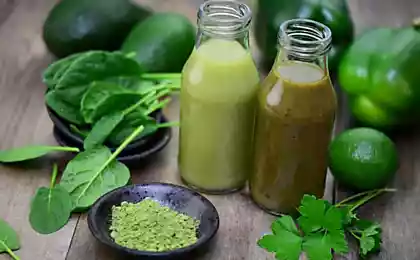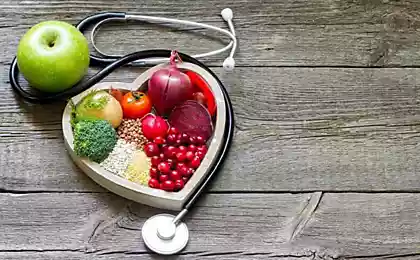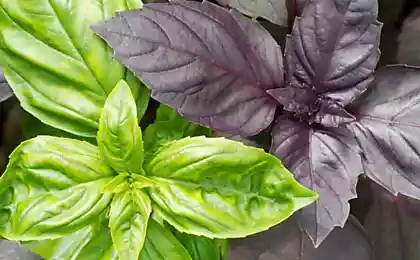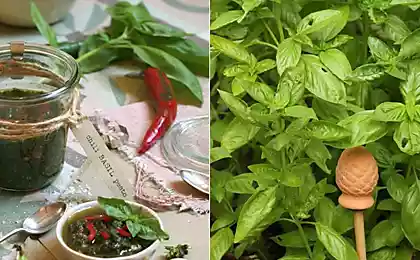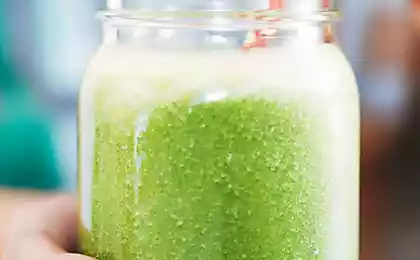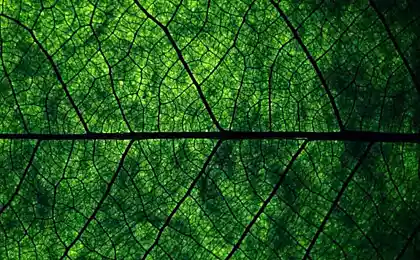469
Basil is the oldest type of edible greens

Basil is one of the oldest types of edible greens. It contains contribute to the health of phytonutrients. In many cultures it was considered a sacred plant. Botanists refer it to the family Lamiaceae and the genus Ocimum. Its scientific name is Ocimum basilicum. Basil has spread around the world from the Asian tropics, India and Iran. The leaves and seeds of annual plants are used in medicine. The Mature plant reaches up to 100 centimeters in height. The leaves of the Asian varieties of Ocimum sanctum — purple, and the Mediterranean Ocimum basilicum green.Mediterranean green Basil also called sweet Basil. Its leaves are light — green and silky and reach about 9 inches in length and 2.5 inches in width, and flowers rather large, pink or white. Asian Basil is known for its pink flowers, purple or red leaves, large hairy stems and pedicels. There is also a "lemon Basil" with a "lemon" flavor. Thai Basil Horapha Asian, but its narrow pointed leaves are light green and have a sweet flavor reminiscent of licorice.
The use of Basil for healthIn the Basil leaves contain many plant-derived chemical compounds known for their abilities to prevent illness and improve health.
Basil contains many polyphenolic flavonoids, including luteolin (orientin) and vicenin. These compounds were tested in the laboratory as a tool, which can provide antioxidant protection against radiation-induced lipid peroxidation in the liver of the mouse.
The Basil leaves contain healthy essential oils. These include eugenol, linalool, citral, limonene and terpineol. These compounds are known for their anti-inflammatory and antibacterial properties.
Basil is very low in calories, while being a rich source of many beneficial nutrients, vitamins and minerals necessary for organism maintenance in a healthy condition.
Basil has an incredibly high content of beta-carotene, vitamin A, cryptoxanthin, lutein and zeaxanthin. These compounds act as scavengers of oxygen free radicals and reactive oxygen species (ROS, ROS), which contribute to the aging process and various diseases.
Zeaxanthin, a yellow flavonoid carotenoid compound, selectively absorbed by the yellow spot of the retina and acts as a filter against harmful ultraviolet rays entering the retina. Studies show that common edible herbs, fruits and vegetables rich in the antioxidant zeaxanthin help to protect from age-related diseases of the retina (age-related macular degeneration).
100 grams of fresh Basil leaves contains 5275 international units (IU, IU) of vitamin A, which is 175% of the recommended daily value of consumption. Vitamin a is known for its antioxidant properties and essential for vision. It is also required to maintain healthy skin and mucous membranes. The drink is rich in vitamin A natural foods helps to prevent cancer of the lungs and mouth.
The Basilica also contains vitamin K, essential for blood clotting, and is also involved in strengthening bone, contributing to the process of mineralization in them.
Basil in appreciable quantities and also contains minerals including potassium, manganese, copper and magnesium. Potassium is an important component fluids of the cells and organism, helps control heart rate and blood pressure. Manganese is used by the body as a contributing factor in the antioxidant enzyme superoxidedismutase.
Basil leaves — excellent source of iron. 100 grams of fresh Basil leaves contains 3.17 MGS of iron, which represents approximately 26% of the recommended daily allowance. Being a component of hemoglobin in red blood cells, iron determines the oxygen capacity of the blood.
Selecting and storing basilicale to give preference to fresh Basilica dark and yellow spots. Sun-dried or subjected to other radiation Basil leaves can lose a significant part of the they contain vitamin C and carotene.
Fresh Basil should be stored in the refrigerator. Dried Basil should be stored in tightly closed glass containers in a cool, dark and dry place. This will keep him up to six months.
Basil in medicine
Contained in the Basilica of essential oils, as mentioned above, have anti-inflammatory and antibacterial properties.
The essential oil eugenol has anti-inflammatory properties and prevents the enzyme cyclooxygenase, which accompanies the inflammatory process in the body and causes symptoms. The ability of eugenol to counteract this enzyme makes Basil protivovpotnam tool in such diseases as rheumatoid arthritis, osteoarthritis, and inflammatory processes in the intestine.
It is believed that Basil oil prevents many pathogenic bacteria, including staphylococci, enterococci, Shigella (the causative agent of dysentery) and Pseudomonas (Escherichia coli).
With all the wonderful beneficial properties of Basil and other edible plants, we should not forget that the treatment for the disease being a doctor.
Nutritional value of BasilIn parentheses are the percentage of the daily allowance. Nutritional value is based on 100 grams fresh Basil leaves Mediterranean varieties of Ocimum basilicum on information from the Ministry of agriculture of the USA, shown in the resource Nutrition And You.
General information:
energy value — 23 kilocalories (1%);
carbohydrates — 2.65 grams (2%);
protein — 3.15 grams (6%);
fats and 0.64 gram (2%);
fiber, part of the food of 1.60 grams (4%).
Vitamins:
folic acid (vitamin B9) 68 micrograms (17%);
nicotinic acid (vitamin B3) is of 0.902 mg (6%);
Pantothenic acid — 0,209 milligram (4%);
pyridoxine (vitamin B6) — 0,155 mg (12%);
Riboflavin (vitamin B2) — 0,076 milligrams (6%);
thiamine (vitamin B1) — 0,034 mg (2,5%);
vitamin A — 5275 international units (IU, IU) is 175%;
vitamin C — 18 mg (30%);
vitamin E is 0.80 milligram (5%);
vitamin K — 414,8 micrograms (345%).
Electrolytes:
sodium — 4 milligrams (~0%);
potassium 295 mg (6%).
Minerals:
calcium 177 mg (18%);
copper — 385 milligrams (43%);
iron — 3,17 milligrams (40%);
magnesium and 64 milligrams (16%);
manganese — 1.15 milligrams (57%);
zinc is 0.81 milligrams (7%).
Phytonutrients:
beta-carotene (ß-carotene), which is rich in carrots — 3142 micrograms;
beta-cryptoxanthin (ß-cryptoxanthin) 46 micrograms;
lutein-zeaxanthin 5650 micrograms.published
Source: hi-news.ru
